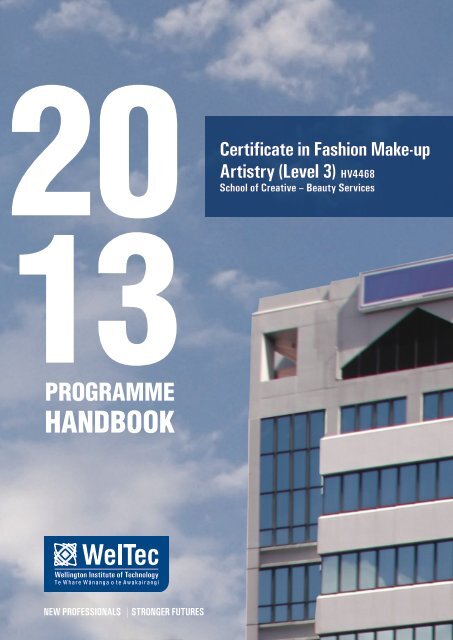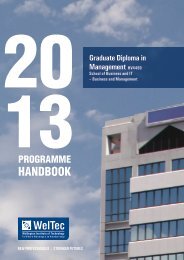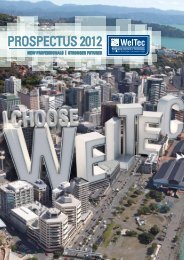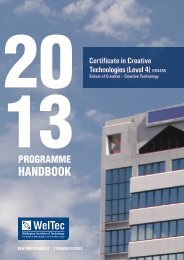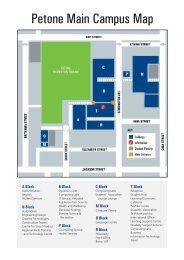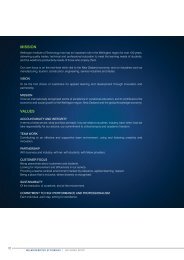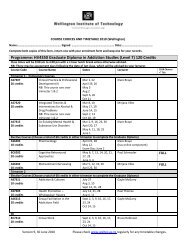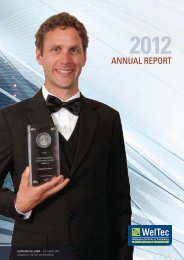HANDBOOK - Wellington Institute of Technology
HANDBOOK - Wellington Institute of Technology
HANDBOOK - Wellington Institute of Technology
You also want an ePaper? Increase the reach of your titles
YUMPU automatically turns print PDFs into web optimized ePapers that Google loves.
PROGRAMME<br />
<strong>HANDBOOK</strong><br />
Certificate in Fashion Make-up<br />
Artistry (Level 3) HV4468<br />
School <strong>of</strong> Creative – Beauty Services
Disclaimer<br />
The information contained in this Programme Handbook is correct at the time <strong>of</strong> publication. However, programmes and courses<br />
are subject to change and WelTec reserves the right to change the content, location or method <strong>of</strong> presentation <strong>of</strong> any<br />
programme or course, and update this Programme Handbook accordingly at any time. The online edition <strong>of</strong> the Programme<br />
Handbook is the <strong>of</strong>ficial Programme Handbook.<br />
Copyright © 2013<br />
<strong>Wellington</strong> <strong>Institute</strong> <strong>of</strong> <strong>Technology</strong> owns copyright in this programme handbook. No part may be reproduced, stored in a retrieval<br />
system or <strong>of</strong>fered for resale without WelTec’s written permission.<br />
<strong>Wellington</strong> <strong>Institute</strong> <strong>of</strong> <strong>Technology</strong> - 2013 Programme Handbook February 2013<br />
HV4468 Certificate in Fashion Make-up Artistry (Level 3)
School <strong>of</strong> Creative<br />
PROGRAMME <strong>HANDBOOK</strong> 2013<br />
HV4468<br />
Certificate in Fashion Make-up Artistry<br />
(Level 3)<br />
<strong>Wellington</strong> <strong>Institute</strong> <strong>of</strong> <strong>Technology</strong> - 2013 Programme Handbook<br />
HV4468 Certificate in Fashion Make-up Artistry (Level 3)<br />
Publication Date: 1 March 2013
HAERE MAI<br />
Whai korōria ki te atua i runga rawa<br />
Maunga rongo ki te whenua<br />
Whakaaro pai ki ngā Tangata Katoa.<br />
Tena Koutou Katoa,<br />
Tēnei te mihi atu ki a koutou ngā Tauira o<br />
Te Whare Wananga o Te Awakairangi.<br />
Nau mai haere mai ki tēnei Wananga o tātou.<br />
Kia kaha koutou ki te whai mātauranga i tēnei tau, ki te whakarongo<br />
hoki ki ō koutou kaiako.<br />
“Whāia te kotahitanga o te wairua.<br />
Mā te rangimārie me te aroha e paihere”<br />
(pursue unity <strong>of</strong> spirit, which is bound together by peace and aroha)<br />
He mihi nui tēnei kia koutou ngā Tauira o<br />
Te Whare Wananga o Te Awakairangi.<br />
Nau mai haere mai ki tēnei Whare Wananga o tātou.<br />
<strong>Wellington</strong> <strong>Institute</strong> <strong>of</strong> <strong>Technology</strong> - 2013 HV4468 Programme Handbook February 2013<br />
Overview and Programme Specific Information Page 4
CONTENTS<br />
HAERE MAI............................................................................................................................................. 4<br />
CHIEF EXECUTIVE’S WELCOME ......................................................................................................... 6<br />
EXECUTIVE DEAN’S WELCOME .......................................................................................................... 7<br />
INTRODUCTION ..................................................................................................................................... 7<br />
ACADEMIC CALENDAR - 2013 ............................................................................................................. 8<br />
STAFF ................................................................................................................................................... 10<br />
AIMS ...................................................................................................................................................... 10<br />
GRADUATE PROFILE .......................................................................................................................... 10<br />
CAREERS ............................................................................................................................................. 11<br />
STAIRCASING ...................................................................................................................................... 11<br />
PROGRESS THROUGH THE PROGRAMME ..................................................................................... 11<br />
GRADUATION CRITERIA .................................................................................................................... 11<br />
LEARNING AND TEACHING................................................................................................................ 12<br />
ASSESSMENT PROCEDURES ........................................................................................................... 12<br />
Assessment Rationale ................................................................................................................ 12<br />
Assessment Schedule ................................................................................................................ 13<br />
Practical Assessment.................................................................................................................. 13<br />
Assessment Cover Sheets ......................................................................................................... 13<br />
Submitting Assessment And Assignment Work ......................................................................... 13<br />
Arranging for Late Submission Of Assessments ........................................................................ 13<br />
Applying For An Extension Beyond The Course End Date ........................................................ 13<br />
Penalty for Unarranged Late Submission ................................................................................... 14<br />
Absence From Supervised Assessments ................................................................................... 14<br />
Reassessment Of Assessments ................................................................................................. 14<br />
Assessment Results Notification ................................................................................................ 14<br />
Challenging Assessment Decisions ............................................................................................ 14<br />
RISK MANAGEMENT, SAFETY AND HEALTH ................................................................................... 15<br />
ATTENDANCE MATTERS .................................................................................................................... 15<br />
ADDITIONAL COSTS ........................................................................................................................... 15<br />
REQUIRED TEXTS ............................................................................................................................... 15<br />
STATIONERY REQUIREMENTS ......................................................................................................... 15<br />
EQUIPMENT REQUIRED ..................................................................................................................... 16<br />
OFF-SITE PRACTICAL AND WORKPLACE COMPONENTS ............................................................. 16<br />
DRESS AND PRESENTATION ............................................................................................................ 16<br />
COMPETITIONS ................................................................................................................................... 16<br />
INFORMED CONSENT AND CONFIDENTALITY................................................................................ 16<br />
PROGRAMME EVALUATION .............................................................................................................. 17<br />
COURSE DESCRIPTORS .................................................................................................................... 18<br />
<strong>Wellington</strong> <strong>Institute</strong> <strong>of</strong> <strong>Technology</strong> - 2013 HV4468 Programme Handbook February 2013<br />
Overview and Programme Specific Information Page 5
WELCOME TO WELTEC<br />
CHIEF EXECUTIVE’S WELCOME<br />
Greetings, Kia Ora, Tal<strong>of</strong>a Lava, Kia Orana, ni sa Bula Vinaka<br />
Kaise Hai, Sat sri akal, Malo e Lelei, Halo Olgeta, Taloha ni<br />
Marhaba, Bozu, Fakal<strong>of</strong>a Lahi Atu, Annyong haseyo, Ni hao, Namaste<br />
Welcome to <strong>Wellington</strong> <strong>Institute</strong> <strong>of</strong> <strong>Technology</strong><br />
Te Whare Wananga o te Awakairangi<br />
In selecting to learn at <strong>Wellington</strong> <strong>Institute</strong> <strong>of</strong> <strong>Technology</strong> (WelTec), you have chosen a place <strong>of</strong><br />
learning that aims to give you not only the working lifestyle you want, but also, a friendly and<br />
comfortable environment where you can feel at home.<br />
By enrolling at WelTec, you are setting out on a learning journey. What you learn and for what<br />
purpose, are your decisions to make. We want to walk beside you as your coach, partner and<br />
mentor; <strong>of</strong>fering support, facilities, opportunities, tools and information to help you reach your<br />
goals.<br />
When you enrol, you will find that the majority, or maybe all, <strong>of</strong> your courses take place on one<br />
campus. Whether your classes are held at our <strong>Wellington</strong> sites, in Auckland, Christchurch, any <strong>of</strong> our<br />
Petone or other sites, all are your campuses.<br />
With your Student ID card, all services and facilities are there for you to use.<br />
Please let us know if you have any queries or needs we haven’t yet met. Best wishes for a happy and<br />
successful year.<br />
Linda Sissons (Dr)<br />
Chief Executive<br />
<strong>Wellington</strong> <strong>Institute</strong> <strong>of</strong> <strong>Technology</strong> - 2013 HV4468 Programme Handbook February 2013<br />
Overview and Programme Specific Information Page 6
EXECUTIVE DEAN’S WELCOME<br />
Welcome to WelTec – your place for learning. As an institute <strong>of</strong> learning you, as a student, are our<br />
key priority.<br />
All staff at WelTec have one primary focus and that is to help facilitate your learning. As you<br />
progress through your studies please take the opportunity to access the facilities and staff support<br />
available.<br />
Your success is our success.<br />
Julia Hennessy (MEd, MMgt, PGDipHSM, BA, DipN)<br />
Executive Dean<br />
INTRODUCTION<br />
This Programme Handbook is intended to provide information relating to the programme you<br />
are enrolled in with WelTec. There is also an associated WelTec A-Z site that has other<br />
helpful information regarding systems and processes that operate at WelTec.<br />
The most up-to-date version <strong>of</strong> this Programme Handbook and the WelTec A-Z general<br />
information is online at:<br />
http://www.weltec.ac.nz/SH/HV4468.pdf<br />
WelTec’s policies that apply to students and this Programme Handbook are located at:<br />
http://www.weltec.ac.nz/SH/Policy/<br />
<strong>Wellington</strong> <strong>Institute</strong> <strong>of</strong> <strong>Technology</strong> - 2013 HV4468 Programme Handbook February 2013<br />
Overview and Programme Specific Information Page 7
TRIMESTER ONE 2013<br />
TRIMESTER TWO 2013<br />
ACADEMIC CALENDAR - 2013<br />
HV4468 Certificate in Fashion Make-Up Artistry (Level 3)<br />
Teaching<br />
Period<br />
Week<br />
No<br />
Monday<br />
date<br />
5 28-Jan<br />
MON TUE WED THU FRI SAT SUN<br />
Auckland<br />
Anniversary<br />
6 4-Feb Waitangi Day<br />
7 11-Feb<br />
8 18-Feb<br />
9 25-Feb<br />
Orientation<br />
Trades<br />
Academy (1)<br />
Mihi<br />
Whakatau;<br />
Orientation<br />
Petone<br />
10 4-Mar Tri 1 Starts<br />
Orientation<br />
Maori<br />
Students<br />
Orientation<br />
Church St,<br />
Cuba St<br />
<strong>Wellington</strong><br />
Orientations:<br />
Auckland;<br />
Trades<br />
Academy (2)<br />
Orientation<br />
Petone<br />
Orientation<br />
Auckland<br />
International<br />
Orientation<br />
Petone<br />
Orientations:<br />
Christchurch;<br />
Youth<br />
Guarantee<br />
11 11-Mar Tri 1 <br />
12 18-Mar<br />
13 25-Mar Easter Break<br />
14 1-Apr Easter Break Easter Break Tri 1+2 <br />
15 8-Apr<br />
Easter<br />
Break<br />
Easter<br />
Break<br />
16 15-Apr<br />
First Aid for<br />
Blue<br />
group 9am<br />
17 22-Apr ANZAC Day<br />
18 29-Apr<br />
19 6-May<br />
20 13-May<br />
21 20-May<br />
22 27-May<br />
23 3-Jun<br />
Queen’s<br />
Birthday<br />
Tri 1 <br />
Makeup<br />
Artistry<br />
Competition<br />
Shoot<br />
24 10-Jun<br />
25 17-Jun<br />
26 24-Jun<br />
27 1-Jul<br />
28 8-Jul<br />
29 15-Jul Tri 2 Starts<br />
Inter- class<br />
prizegiving<br />
Tri 1 Ends<br />
Tri 1 Results<br />
Completed<br />
30 22-Jul Tri 2 <br />
31 29-Jul Tri 1+2 <br />
32 5-Aug Tri 2+3 <br />
33 12-Aug<br />
34 19-Aug<br />
Graduation<br />
<strong>Wellington</strong><br />
35 26-Aug<br />
36 2-Sep<br />
37 9-Sep<br />
38 16-Sep<br />
39 23-Sep<br />
<strong>Wellington</strong> <strong>Institute</strong> <strong>of</strong> <strong>Technology</strong> - 2013 HV4468 Programme Handbook February 2013<br />
Overview and Programme Specific Information Page 8
TRIMESTER THREE – 2013<br />
Teaching<br />
Period<br />
Week<br />
No<br />
Monday<br />
date<br />
40 30-Sep<br />
41 7-Oct<br />
MON TUE WED THU FRI SAT SUN<br />
42 14-Oct Tri 2 <br />
43 21-Oct<br />
44 28-Oct Labour Day<br />
45 4-Nov Tri 2 Ends<br />
46 11-Nov Tri 3 Starts<br />
47 18-Nov<br />
48 25-Nov<br />
Canterbury<br />
Anniversary<br />
Tri 2<br />
Tri2 Results<br />
Completed<br />
49 2-Dec<br />
50 9-Dec<br />
51 16-Dec<br />
52 23-Dec WelTec closed for Christmas<br />
1<br />
30-Dec-<br />
13<br />
2 6-Jan-14<br />
3 13-Jan<br />
Tri 2+3 <br />
4 20-Jan<br />
5 27-Jan<br />
<strong>Wellington</strong><br />
Anniversary<br />
Auckland<br />
Anniversary<br />
WelTec closed for New Year Holidays<br />
6 3-Feb<br />
Tri 3 Waitangi Day<br />
7 10-Feb<br />
8 17-Feb<br />
9 24-Feb Tri 3 Ends<br />
10 3-Mar Tri 1 Starts<br />
11 10-Mar<br />
Tri 3 Results<br />
Completed<br />
Enr period Last date to change or withdraw in that enrolment period with refund<br />
Enr period<br />
Last date to withdraw (75% <strong>of</strong> course enrolment period)<br />
The up-to-date, day-to-day and week-by-week timetables are located at:<br />
http://timetable.weltec.ac.nz/.<br />
<strong>Wellington</strong> <strong>Institute</strong> <strong>of</strong> <strong>Technology</strong> - 2013 HV4468 Programme Handbook February 2013<br />
Overview and Programme Specific Information Page 9
STAFF<br />
Faculty Executive Dean:<br />
Julia Hennessy<br />
School:<br />
Creative<br />
Head <strong>of</strong> School:<br />
Teriu Lemon<br />
Phone/extension 3021<br />
E-mail<br />
teriu.lemon@weltec.ac.nz<br />
Associate Head <strong>of</strong> School: Debra Hawkins<br />
Phone/extension 744<br />
E-mail<br />
debra.hawkins@weltec.ac.nz<br />
School Business Administrator: Cathy Woods<br />
Phone/extension 633<br />
E-mail<br />
cathy.woods@weltec.ac.nz<br />
Staff Member Qualifications Position Email Address<br />
<strong>Wellington</strong> Church Street Campus: 0800 WELTEC (935 832)<br />
ADAMS, Caroline ASM Caroline.adams@weltec.ac.nz<br />
WILDEY, Olivia ASM Olivia.wildey@weltec.ac.nz<br />
AIMS<br />
The aims <strong>of</strong> this programme are:<br />
• To provide an introduction to the make-up artistry industry, and to provide the knowledge<br />
and skills to gain employment as a make-up artistry consultant in pharmacies, cosmetic<br />
counters, make-up houses, and television.<br />
• To provide the necessary knowledge and skills required to perform editorial and<br />
photographic make-up and hairstyling.<br />
• To enable students to develop literacy and numeracy skills relevant to the make-up artistry<br />
industry, and for further study<br />
GRADUATE PROFILE<br />
A graduate <strong>of</strong> the Certificate in Fashion Make-up Artistry (Level 3) will be able to:<br />
• Prepare skin for make-up application<br />
• Create day make-up and hairstyling<br />
• Investigate past, present and future fashion trends and translate into make-up and hair<br />
designs<br />
• Create total looks for different medias, including fashion photographic work and fashion<br />
catwalk work<br />
• Comply with the service requirements <strong>of</strong> a pr<strong>of</strong>essional make-up artist<br />
• Manipulate character features and hair by application <strong>of</strong> make-up and hairstyling<br />
• Create period inspired looks by application <strong>of</strong> make-up and hairstyling<br />
<strong>Wellington</strong> <strong>Institute</strong> <strong>of</strong> <strong>Technology</strong> - 2013 HV4468 Programme Handbook February 2013<br />
Overview and Programme Specific Information Page 10
Holders <strong>of</strong> this qualification may apply for entry into further tertiary education and training<br />
programmes relating to this field <strong>of</strong> study. These include the Certificate in Special Effects<br />
and Make-up Artistry.<br />
Graduates <strong>of</strong> this certificate will have the minimum qualification to enter into a supervised<br />
position within the make-up artistry industry.<br />
Employment opportunities include positions in pharmacies, cosmetic counters, make-up<br />
houses, and television.<br />
Gradates will have acquired a range <strong>of</strong> literacy and numeracy skills equipping them for<br />
employment, or for continuing study.<br />
CAREERS<br />
Entry into a supervised position within the make-up artistry industry as a make-up artist<br />
including pharmacies, cosmetic counters, make-up houses and television.<br />
STAIRCASING<br />
Successful completion provides entry into:<br />
• HV4469 Certificate in Special Effects and Make-up Artistry (Level 4)<br />
• HV4416 Diploma in Beauty Therapy (Level 5)<br />
PROGRESS THROUGH THE PROGRAMME<br />
Students should complete the programme in one trimester, fulltime.<br />
GRADUATION CRITERIA<br />
To receive HV4468 Certificate in Fashion Make-up Artistry (Level 3) you must successfully<br />
complete the following four courses:<br />
Course Number<br />
MA3008<br />
MA3009<br />
MA2005<br />
MA3010<br />
Course Title.<br />
Day Make-up and Hairstyling<br />
Fashion Make-up and Hairstyling<br />
Customer Service<br />
Character and Period Make-up and Hairstyling<br />
Schedule <strong>of</strong> Pre- and Co- Requisites:<br />
Course<br />
Number<br />
Course Title. Level Credits Pre (P) or -Co (C)<br />
Requisites<br />
MA3008 Day Make-up and Hairstyling 3 15 MA2005 (C)<br />
MA3009 Fashion Make-up and<br />
Hairstyling<br />
3 15 MA3008 (P)<br />
MA2005(C)<br />
MA2005 Customer Service 2 15 MA3008 (C)<br />
MA3009 (C)<br />
MA3010 (C)<br />
MA3010 Character and Period Make-up<br />
and Hairstyling<br />
3 15 MA3008 (P)<br />
MA2005 (C)<br />
<strong>Wellington</strong> <strong>Institute</strong> <strong>of</strong> <strong>Technology</strong> - 2013 HV4468 Programme Handbook February 2013<br />
Overview and Programme Specific Information Page 11
LEARNING AND TEACHING<br />
The make-up artistry and hairdressing tutors teach and deliver to encourage personal input<br />
and creative ideas from the students.<br />
Theory presentations are student focused and practical demonstrations are made fun and<br />
enjoyable.<br />
You are required to perform tasks repeatedly so dedication and enthusiasm is a must.<br />
ASSESSMENT PROCEDURES<br />
You need to become familiar with the assessment procedures for your courses and this<br />
Programme. Overall Programme procedures are given below. There may also be course<br />
specific assessment procedures and requirements noted in your Course Outlines.<br />
Please note that all activities that contribute towards your final course grades, and therefore<br />
your qualification completion, are known as assessments (summative assessments to be<br />
precise). There are many different types <strong>of</strong> assessment activities your tutors use in your<br />
courses.<br />
The WelTec Academic Regulations section 7 require that you:<br />
<br />
<br />
make yourself available to undertake all summative assessment items at the time<br />
and place stipulated by the teaching staff responsible for the course<br />
act with integrity (honesty) during assessments. You are expected to:<br />
o Submit material that is your own original work<br />
o Collaborate only as permitted<br />
o Acknowledge contributions from other sources by using APA reference format<br />
(failure to do this correctly may be regarded as plagiarism)<br />
o Keep written and electronic work secure to prevent others from accessing and<br />
copying work<br />
o Understand the definition <strong>of</strong> academic dishonesty and the consequences <strong>of</strong><br />
breaching the regulations (see Academic Regulations S12 Dishonest Practice).<br />
WelTec conducts assessments within rules set out in the following regulations and policies:<br />
The Academic Regulations 2013<br />
o Examination Rules<br />
o Aegrotat regulations<br />
o Grades<br />
o Results<br />
o Challenging Assessment Decisions<br />
o Dishonest Practice in Assessment<br />
o Appeals<br />
Policy 3.05 Assessment Policy<br />
o Definitions<br />
o Guidelines for assessment practice<br />
Policy 3.07 Programme Moderation Policy<br />
o Quality assurance processes before using the assessment activity<br />
o Quality assurance processes after marking to verify marker’s consistency<br />
You may ask your tutors at any time about the quality-assured status <strong>of</strong> the assessment<br />
activities you are asked to complete.<br />
Assessment Rationale<br />
The courses in this programme are assessed using competency-based methods.<br />
You will be assessed for each course. The assessments may be by observation, projects,<br />
assignments, presentations, reports, multiple choice questions, tests and can also take the<br />
<strong>Wellington</strong> <strong>Institute</strong> <strong>of</strong> <strong>Technology</strong> - 2013 HV4468 Programme Handbook February 2013<br />
Overview and Programme Specific Information Page 12
form <strong>of</strong> role-plays. Role-plays and presentations may be videoed. There may also be a<br />
requirement for students to work in groups.<br />
Assessment Schedule<br />
Please refer to your Course Outline for the Assessment Schedule for each <strong>of</strong> your Courses.<br />
The Schedule will detail the assessment type (test, assignment, presentation, etc), the topic<br />
being assessed, due dates, and if appropriate the weighting. Any other conditions will also<br />
be noted as they apply to the assessments for that course.<br />
Practical Assessment<br />
You will be required to supply a model for practical assessments. The model you bring must<br />
be suitable for the service. This is to certify that you are able to perform a service on an<br />
individual who you do not know. To complete all practical 100% competency must be shown.<br />
Inability to supply a model on the day <strong>of</strong> assessment will result in an incomplete assessment.<br />
Please let Tutors know well in advance if you are having problems finding a model. It will not<br />
be acceptable on the day <strong>of</strong> an assessment to inform the assessor <strong>of</strong> your difficulties.<br />
Assessment Cover Sheets<br />
A Student Assessment Cover Sheet must be attached to all assessments handed/posted in.<br />
If you’re on campus you can find this form on the Student Intranet:<br />
1. Click on Forms and Documents > Assessment Forms<br />
2. Click on Student Assignment Cover Sheet – ASF007<br />
3. Print <strong>of</strong>f the form.<br />
If you are not on campus you can access them on the WelTec website:<br />
a. Go to the WelTec website: www.weltec.ac.nz/PH/<br />
b. Use the CITRIX link to login to WelTec's intranet (see the A-Z for details)<br />
c. Use instructions 1-3 above to print the cover sheet.<br />
Submitting Assessment And Assignment Work<br />
It is essential that you meet the assessment submission deadlines notified in your Course<br />
Outlines' assessment schedules - unless you have pre-arranged for a late submission with<br />
your tutor. Please refer to your course outlines for any penalties for late submission <strong>of</strong><br />
assessments.<br />
Some assessments may have time-related criteria attached to them. Your course outline will<br />
notify you <strong>of</strong> these particular assessments, and the reasons for the time criteria. Lateness,<br />
absence or early departure from these assessments may carry specific penalties.<br />
Arranging for Late Submission Of Assessments<br />
In case <strong>of</strong> illness, injury or exceptional circumstances you may request to make a<br />
submission after the assessment due date by submitting a Request for Late Submission<br />
Form prior to the due date. On receiving your Request, your tutor may negotiate a new<br />
submission date/time. Where work has been handed in late without approval, late<br />
assessment submission provisions will apply.<br />
Applying For An Extension Beyond The Course End Date<br />
If you are prevented by illness, injury or exceptional circumstances from completing an<br />
assessment by the course end date, you may apply to the Associate Head <strong>of</strong> School for an<br />
extension to complete the assessment.<br />
The application is to be made in writing as soon as possible and not later than 48 hours<br />
before the assessment due time and date. The application is made on the WelTec Course<br />
Extension Form available from the Student Information Centre and the WelTec website.<br />
<strong>Wellington</strong> <strong>Institute</strong> <strong>of</strong> <strong>Technology</strong> - 2013 HV4468 Programme Handbook February 2013<br />
Overview and Programme Specific Information Page 13
Where there are valid reasons, the Associate Head <strong>of</strong> School may grant an extension for a<br />
period <strong>of</strong> no more than three weeks after the course end date. A longer than three weeks’<br />
extension may be recommended by the Associate Head <strong>of</strong> School to the Board <strong>of</strong> Studies'<br />
Achievement Sub-Committee for approval, where there are extenuating circumstances that<br />
justify a longer extension.<br />
Penalty for Unarranged Late Submission<br />
There will be no late submissions without an agreed arrangement.<br />
Absence From Supervised Assessments<br />
If for any reason you are not able to make your assessment, you are to advise your Tutor no<br />
later than 7 days prior to the assessment date set. You will need to supply a medical<br />
certificate.<br />
YOU WILL ALSO NEED TO SUPPLY A MODEL OF YOUR OWN CHOICE TO PERFORM<br />
YOUR ASSESSMENT.<br />
Reassessment Of Assessments<br />
All students will have first attempt and first resit opportunity. A second and final resit<br />
opportunity may be approved by your tutor. The second resit incurs a fee <strong>of</strong> $15.00 plus any<br />
required product costs. This is to be paid on or before the day <strong>of</strong> the scheduled resit.<br />
Assessment Results Notification<br />
Course assessment and final grades are reported using the Grade Key 1 method. Grade<br />
Keys are explained in Appendix 2 <strong>of</strong> the Academic Regulations.<br />
Once your tutor has marked your assessments you will be notified <strong>of</strong> your result.<br />
• If the assessment is in the form <strong>of</strong> a practical in-class demonstration/observation, you are<br />
likely to get your results immediately or shortly after the assessment activity has concluded.<br />
• If the assessment is a supervised test you are able to review your work, but the<br />
assessment is collected and retained by WelTec.<br />
• If you hand in an assignment it is returned to you along with feedback to explain the<br />
reason(s) for the assessment result.<br />
• If you sit a final exam you are able to view your result online at the student results portal:<br />
https://results.weltec.ac.nz within 15 working days.<br />
Results for each assessment are available within 15 working days on WelTec's Student<br />
Results portal at: https://results.weltec.ac.nz.<br />
Use your normal WelTec login and password to access a number <strong>of</strong> items, such as your<br />
assessment results, current course enrolments, and other details.<br />
Challenging Assessment Decisions<br />
If you have reason to believe that the grade or mark for a particular assessment is incorrect,<br />
you should firstly discuss this with your tutor within five (5) working days <strong>of</strong> the return <strong>of</strong> the<br />
assessment.<br />
Your tutor will provide feedback to clarify why the grade or mark has been awarded and<br />
may, if justified, amend the result.<br />
If you still believe that the mark or grade is incorrect, you should discuss the matter with the<br />
Associate Head <strong>of</strong> School.<br />
For more information on Challenging Assessment Decisions please refer to the WelTec<br />
Academic Regulations 2013 - section 11.<br />
<strong>Wellington</strong> <strong>Institute</strong> <strong>of</strong> <strong>Technology</strong> - 2013 HV4468 Programme Handbook February 2013<br />
Overview and Programme Specific Information Page 14
RISK MANAGEMENT, SAFETY AND HEALTH<br />
WelTec students share the responsibility <strong>of</strong> maintaining a safe and healthy working<br />
environment whether on campus or studying <strong>of</strong>f-site (See Student Code <strong>of</strong> Conduct, Section<br />
3.4).<br />
ATTENDANCE MATTERS<br />
An objective <strong>of</strong> study with WelTec is to prepare you for your career in industry. Your attitude,<br />
attendance and behaviour are important. Please give your best effort and ensure your<br />
behaviour and attendance reflect your desire to do well.<br />
You should therefore be present on time, fully equipped and, if applicable, dressed and<br />
groomed appropriately for practical sessions.<br />
You are expected to attend all classes and assessments as timetabled. If you are not able to<br />
attend then you should notify your course tutor.<br />
Note that a student on student allowances/living costs who does not:<br />
• meet prescribed attendance requirements, and/or<br />
• disengages in their learning and assessments, and<br />
• does not respond to contact from the institute,<br />
will be notified to Academic Records and Administration. It is your responsibility to inform<br />
StudyLink if you change your study details.<br />
All daytime classes will have a common start time on the hour and must finish by 50 minutes<br />
past the hour, to allow time for students and staff to arrive at their next class on time.<br />
ADDITIONAL COSTS<br />
Certificate in Fashion Makeup Artistry HV4468<br />
Course related costs<br />
Kit $ 320.00<br />
Craft materials/accessories $30.00<br />
Total $350.00<br />
Students will need to provide:<br />
• Digital camera for photographic work<br />
REQUIRED TEXTS<br />
Your Course Descriptors may identify some text books as required, and/or recommended<br />
textbooks. Please refer to your Course Outlines for the most up-to-date edition information.<br />
Textbooks are available for purchase from vicBooks, <strong>Wellington</strong>, or as specified in the<br />
Course Outlines.<br />
STATIONERY REQUIREMENTS<br />
You are required to provide items, such as stationery, for your study programme. Tutors will<br />
confirm with you where other equipment and/or materials are required for specific courses or<br />
classes.<br />
<strong>Wellington</strong> <strong>Institute</strong> <strong>of</strong> <strong>Technology</strong> - 2013 HV4468 Programme Handbook February 2013<br />
Overview and Programme Specific Information Page 15
EQUIPMENT REQUIRED<br />
Where personal equipment is required for safety reasons, students may be denied entry to<br />
the class if they do not have such equipment at the time <strong>of</strong> the class.<br />
Certificate in Fashion Makeup Artistry HV4468<br />
Course related costs<br />
Kit $ 320.00<br />
Craft materials/accessories $30.00<br />
Total $350.00<br />
Students will need to provide:<br />
• Digital camera for photographic work<br />
OFF-SITE PRACTICAL AND WORKPLACE COMPONENTS<br />
There are no <strong>of</strong>f-site practical/workbased components in the programme.<br />
DRESS AND PRESENTATION<br />
You are now in the fashion industry. A high standard <strong>of</strong> personal presentation is essential!<br />
You must portray a pr<strong>of</strong>essional image at all times. Failure to do so will result you being<br />
sent away to change.<br />
Further guidelines will be presented to you during your programme.<br />
COMPETITIONS<br />
Internal Competitions<br />
In the event <strong>of</strong> the student being awarded first prize, the student is eligible to keep the prize<br />
and/or Certificate. The trophy will remain the property <strong>of</strong> WelTec and the students name will<br />
be engraved with the year <strong>of</strong> achievement. This will be displayed in the hairdressing and<br />
beauty therapy salon.<br />
External Competitions<br />
Where a student is awarded a trophy and/or gift as part <strong>of</strong> a winning prize, the student is<br />
eligible to keep the prize and certificate given. The trophy will remain the property <strong>of</strong> WelTec<br />
and be kept on site in the hairdressing and beauty therapy salon. A replacement trophy/cup<br />
will be issued at the end <strong>of</strong> the programme to the student.<br />
INFORMED CONSENT AND CONFIDENTALITY<br />
This programme requires students to gain experience in applying a range <strong>of</strong> make-up and<br />
facial products, styling hair and practical hairdressing. As most <strong>of</strong> the learning occurs within<br />
the classroom, it is usual practice for the students within the class to perform practical<br />
applications on each other.<br />
To ensure that students are aware <strong>of</strong> this requirement <strong>of</strong> the programme they are required to<br />
complete an “Informed Consent” form prior to the commencement <strong>of</strong> the programme.<br />
Students will receive all the relevant information to enable them to consent to the conditions<br />
without external constraints or pressures.<br />
The Informed Consent form complies with the requirements set out in BPM 8.2 Human<br />
Ethics Policy.<br />
<strong>Wellington</strong> <strong>Institute</strong> <strong>of</strong> <strong>Technology</strong> - 2013 HV4468 Programme Handbook February 2013<br />
Overview and Programme Specific Information Page 16
PROGRAMME EVALUATION<br />
WelTec is interested in the experience students have during their time studying. As well as<br />
informal conversations with students, there are three main surveys available to students to<br />
express their views and rate WelTec services.<br />
As a student new to WelTec:<br />
In the first few weeks you will be invited to participate in the WelTec EV1 - First Impressions<br />
survey (www.surveymonkey.com/s/WelTecEV1). This is open to first-time WelTec students,<br />
and asks for your rating <strong>of</strong> and views about your enrolment experience, the initial in-class<br />
experience, and also your experience <strong>of</strong> our online resource systems, Moodle or LearnZone.<br />
During your course time:<br />
Your course outline may indicate that your course will have an EV4 - Teacher and Course<br />
Evaluation undertaken towards the end. This helps the Programme Team to improve the<br />
teaching, the course, and the value <strong>of</strong> the Programme to students. Note: you will need a<br />
specific 'survey event code' supplied by the survey administrator to use the EV4.<br />
At the end <strong>of</strong> the programme or year:<br />
In the final few weeks <strong>of</strong> the programme, or year, you will be invited to participate in the EV3<br />
- Student Satisfaction Survey (www.surveymonkey.com/s/WelTecEV3). This asks you about<br />
your overall experience <strong>of</strong> WelTec's services, the programme, teaching, skills development,<br />
career enhancement, and overall satisfaction.<br />
All WelTec surveys are anonymous; we do not ask you for identification. We do however ask<br />
for some demographic information (age range, sex, enrolment types, ethnicity, etc.) in order<br />
to make sense <strong>of</strong> trends for particular learner groups.<br />
The outcomes <strong>of</strong> the surveys are reported as aggregated information and tables to the<br />
WelTec Academic Committee. The reports are also made available to students.<br />
<strong>Wellington</strong> <strong>Institute</strong> <strong>of</strong> <strong>Technology</strong> - 2013 HV4468 Programme Handbook February 2013<br />
Overview and Programme Specific Information Page 17
COURSE DESCRIPTORS<br />
Course Descriptors are the formally approved documents that describe:<br />
<br />
<br />
<br />
<br />
<br />
<br />
The course title, level, credit value<br />
The aims <strong>of</strong> the course<br />
What you will be learning – the Learning Outcomes that guide the content and<br />
process <strong>of</strong> your learning experiences and activities with your tutor<br />
The assessment activities you need to complete to show how well you have<br />
developed your skills and knowledge against the requirements <strong>of</strong> the Learning<br />
Outcomes<br />
The texts or resources that you are required to purchase. Note: for some courses the<br />
latest texts may be listed either in the Required Texts section above, or in your<br />
Course Outline. If you are not certain, clarify the text or edition with your tutor.<br />
Any external standards that the course is also meeting the requirements <strong>of</strong> (may be<br />
unit standards, pr<strong>of</strong>essional bodies, vendor certifications, etc.)<br />
Course Outlines, which your tutors will provide to you in class, or through LearnZone or<br />
Moodle, contextualise the Descriptors for your particular class for this year. The Outline<br />
should provide you with tutor information, specific course topic schedules, assessment<br />
dates, specific rules and requirements, and other useful information.<br />
The course descriptors for this programme make up the rest <strong>of</strong> this Programme Handbook<br />
on the following pages.<br />
Note: Please be aware that it may be that not all courses listed are be <strong>of</strong>fered in any given<br />
trimester or year. For further information on this please contact your Student Advisor.<br />
<strong>Wellington</strong> <strong>Institute</strong> <strong>of</strong> <strong>Technology</strong> - 2013 HV4468 Programme Handbook February 2013<br />
Overview and Programme Specific Information Page 18
COURSE TITLE:<br />
Course Number:<br />
Day Make-up and Hairstyling<br />
MA3008<br />
Level: 3<br />
Credits: 15<br />
Pre or Co requisites: MA2005 (C)<br />
Learning Hours:<br />
Face-to-face tuition 70<br />
Self-directed with tutorial support<br />
available<br />
Online<br />
Distance (not online)<br />
Resource based learning (not<br />
online)<br />
Workplace learning<br />
Supervised work experience<br />
Self-directed (out <strong>of</strong> class without direct<br />
tutorial support)<br />
Workplace project<br />
10<br />
58<br />
Tests and examinations 12<br />
Other<br />
(State)……………………………..<br />
Total learning hours 150<br />
Aim(s):<br />
To gain the knowledge and skills to perform a basic skin cleansing routine and<br />
prepare the skin for make-up application; and to create a day ‘look’ using basic<br />
corrective make-up and elementary hairstyling techniques to best suit the overall<br />
look, or desired result.<br />
Topic(s) or summary <strong>of</strong> content:<br />
1. Prepare Skin<br />
2. Day Make-up Application<br />
3. Elementary Hairstyling<br />
4. Hair Product Knowledge
Topic 1:<br />
Prepare Skin<br />
Learning Outcome:<br />
Students will be able to:<br />
<br />
<br />
Identify and carry out a skin and hair analysis; prepare hair; and select<br />
appropriate products to perform a basic skin cleanse-tone-moisturise routine<br />
Display knowledge <strong>of</strong> make-up primer products and elementary styling<br />
- recognise and use written texts in course-specific documents<br />
- recognise and use specialised vocabulary and terminology in context<br />
Assessment criteria:<br />
1.1 Select appropriate products and carry out a basic skincare routine and hair<br />
preparation<br />
1.2 Select appropriate make-up primer products and prepare the face for a make-up<br />
application to meet the desired result<br />
Topic 2:<br />
Day Make-up Application<br />
Learning Outcome(s):<br />
Students will be able to:<br />
Apply corrective make-up techniques to evenly balance the face; apply<br />
make-up to create a day look; and style hair to suit the created day look and<br />
to client requirements<br />
- Respond to dialogue appropriately and with understanding<br />
- Respond appropriately to spoken requests in conversations<br />
- Respond to and use appropriate skills and language to manage<br />
interactions<br />
Assessment criteria:<br />
2.1 Create a day make-up, using corrective techniques<br />
2.2 Style the hair to suit the day-look and to client requirements.<br />
Topic 3:<br />
Elementary Hair-styling<br />
Learning Outcome(s):<br />
Students will be able to:<br />
<br />
Create a variety <strong>of</strong> elementary styles using blow drying techniques and long<br />
hair styling<br />
- Respond appropriately to spoken instructions specific to course<br />
related task and activities<br />
- Respond to and use appropriate skills and language to manage<br />
interactions<br />
Assessment criteria:<br />
3.1 Create a variety <strong>of</strong> elementary styles using blow drying techniques. Range:<br />
must include scrunch blow dry, finger blow dry, brush blow dry<br />
3.2 Create a design for a desired style. Range: must include bridal hair up,<br />
elegant/glamorous hairstyle, sultry/funky hairstyle
3.3 Select and apply appropriate products to create desired style<br />
Topic 4:<br />
Hair Product Knowledge<br />
Learning Outcome(s):<br />
Students will be able to:<br />
Select and apply appropriate styling and finishing hair products<br />
- Recognise and use written texts in course-specific documents<br />
- Recognise and use specialised vocabulary and terminology in<br />
context<br />
- Use reading strategies to read a range <strong>of</strong> texts for specific purposes<br />
- Use learning resource effectively<br />
Assessment criteria:<br />
4.1 Select and apply appropriate hair products for a variety <strong>of</strong> hair types. Range:<br />
must include fine hair, oily hair, dry hair.<br />
Student Resources:<br />
Recommended texts are listed in the course handbook.<br />
Assessment:<br />
Assignment<br />
Practical demonstration<br />
Reporting Grades:<br />
Grade Key 1<br />
Successful Completion <strong>of</strong> Course:<br />
Students must achieve competence in all learning outcomes.<br />
Note:<br />
The embedded literacy and numeracy outcomes under the course descriptor refer to the<br />
Tertiary Education Commission (TEC) Foundation Learning Progressions framework. These<br />
outcomes indicate the literacy and numeracy skills necessary for the learner to achieve on<br />
each component <strong>of</strong> the course.
COURSE TITLE:<br />
Course Number:<br />
Fashion Make-up and Hairstyling<br />
MA3009<br />
Level: 3<br />
Credits: 15<br />
Pre or Co requisites: MA2005 (C, MA3008 (P)<br />
Learning Hours:<br />
Face-to-face tuition 70<br />
Self-directed with tutorial support<br />
available<br />
Online<br />
Distance (not online)<br />
Resource based learning (not<br />
online)<br />
Workplace learning<br />
Supervised work experience<br />
Self-directed (out <strong>of</strong> class without direct<br />
tutorial support)<br />
Workplace project<br />
20<br />
48<br />
Tests and examinations 12<br />
Other<br />
(State)……………………………..<br />
Total learning hours 150<br />
Aim(s):<br />
To gain knowledge <strong>of</strong> the different aspects <strong>of</strong> the fashion industry and to identify<br />
past, present and future fashion trends and translate them into make-up and hair<br />
designs. To gain knowledge <strong>of</strong> the difference between work for editorial purposes<br />
and work for catwalk purposes; and work with designer briefing guidelines. To gain<br />
the skills to produce a portfolio.<br />
Topic(s) or summary <strong>of</strong> content:<br />
1. Fashion Make-up and Hair<br />
2. Catwalk Make-up and Hair<br />
3. Editorial/photographic Make-up and Hair<br />
4. Theme/topic Make-up and Hair<br />
5. Portfolio Development
Topic 1:<br />
Fashion Make-up and Hair<br />
Learning Outcome:<br />
Students will be able to:<br />
<br />
Investigate fashion trends in make-up and hairstyling and apply selected<br />
look on a model<br />
- Plan and write texts using appropriate format<br />
- Use reading strategies to read a range <strong>of</strong> texts for specific purposes<br />
- Use learning resources effectively<br />
- Respond to and use appropriate skills and language to manage<br />
interactions<br />
Assessment criteria:<br />
1.1 Investigate fashion trends in make-up and hairstyling<br />
1.2 Create a design and explain how the trends used in the make-up and hairstyle<br />
will suit the model<br />
1.3 Create the overall “look” on a model<br />
Topic 2:<br />
Catwalk Make-up and Hair<br />
Learning Outcome(s):<br />
Students will be able to:<br />
<br />
Create make-up and hairstyling to complement an outfit for the catwalk, to<br />
industry standards<br />
- Recognise and use specialised vocabulary and terminology in<br />
context<br />
- Respond to and use appropriate skills and language to manage<br />
interactions<br />
- Plan and write texts using appropriate format<br />
Assessment criteria:<br />
2.1 Create make-up and a hair style to complement an outfit for the catwalk<br />
Topic 3:<br />
Editorial/photographic Make-up and Hair<br />
Learning Outcome(s):<br />
Students will be able to:<br />
<br />
Create a make-up and hair design suitable to be photographed for a head<br />
shot in colour, and black and white; and design and photograph an overall<br />
make-up “look” for a colour and black and white photo session<br />
- Recognise and use specialised vocabulary and terminology in<br />
context<br />
- Respond to and use appropriate skills and language to manage<br />
interactions<br />
- Plan and write texts using appropriate format
Assessment criteria:<br />
3.1 Design an overall make-up “look” for a colour, and black and white photo session<br />
for a head shot<br />
3.2 Photograph the “look” for a colour, and black and white photo session<br />
Topic 4:<br />
Theme/topic Make-up and Hair<br />
Learning Outcome(s):<br />
Students will be able to:<br />
Investigate a theme or topic and create a make-up and hair design inspired<br />
by the theme or topic; and present the inspiration process on a mood board<br />
- Plan and write texts using appropriate format<br />
- Write for a specific purpose and audience<br />
- Recognise and use specialised vocabulary and terminology in<br />
context<br />
- Use reading strategies to read a range <strong>of</strong> texts for specific purposes<br />
- Use learning resources effectively<br />
Assessment criteria:<br />
4.1 Investigate a given theme or topic<br />
4.2 Design a make-up and hair “look” inspired by the theme or topic<br />
4.3 Create the “look” on a model<br />
4.4 Present the process on a mood board.<br />
Topic 5:<br />
Portfolio Development<br />
Learning Outcome(s):<br />
Students will be able to:<br />
Create own design <strong>of</strong> make-up and hair using a range <strong>of</strong> visual and written<br />
techniques and present ideas and design on a mood board; and produce a<br />
portfolio using photography and computer imaging, and time management<br />
skills<br />
- Plan and write texts using appropriate format<br />
- Write for a specific purpose and audience<br />
- Write text accurately<br />
- Accurately record written information<br />
- Recognise and use specialised vocabulary and terminology in<br />
context<br />
- Use reading strategies to read a range <strong>of</strong> texts for specific purposes<br />
- Use learning resources effectively<br />
- Select and use sensible units to measure<br />
- Select appropriate methods to estimate<br />
Assessment criteria:<br />
5.1 Produce a range <strong>of</strong> work for selection for a final portfolio within given deadlines<br />
5.2 Select and edit ten photographic material for portfolio<br />
5.3 Select and edit design material for portfolio<br />
5.4 Present a portfolio <strong>of</strong> completed work to industry presentation standards within
given deadlines<br />
5.5 Produce a mood board for the end <strong>of</strong> course competition presentation<br />
Student Resources:<br />
Recommended texts are listed in the course handbook.<br />
Assessment:<br />
Assignment<br />
Practical demonstration<br />
Reporting Grades:<br />
Grade Key 1<br />
Successful Completion <strong>of</strong> Course:<br />
Students must achieve competence in all learning outcomes.<br />
Note:<br />
The embedded literacy and numeracy outcomes under the course descriptor refer to the<br />
Tertiary Education Commission (TEC) Foundation Learning Progressions framework. These<br />
outcomes indicate the literacy and numeracy skills necessary for the learner to achieve on<br />
each component <strong>of</strong> the course.
COURSE TITLE:<br />
Course Number:<br />
Customer Service<br />
MA2005<br />
Level: 2<br />
Credits: 15<br />
Pre or Co requisites: MA3008 (C), MA3009 (C), MA3010 (C)<br />
Learning Hours:<br />
Face-to-face tuition 65<br />
Self-directed with tutorial support<br />
available<br />
Online<br />
Distance (not online)<br />
Resource based learning (not<br />
online)<br />
Workplace learning<br />
Supervised work experience<br />
Self-directed (out <strong>of</strong> class without direct<br />
tutorial support)<br />
Workplace project<br />
Tests and examinations 6<br />
Other<br />
(State)……………………………..<br />
24<br />
55<br />
Total learning hours 150<br />
Aim(s):<br />
To gain knowledge and skills <strong>of</strong> the service requirements <strong>of</strong> a make-up pr<strong>of</strong>essional,<br />
including personal presentation and communication; and to provide basic life support.<br />
To gain knowledge <strong>of</strong> responsibilities and expectations when performing a make-up<br />
consultation.<br />
Topic(s) or summary <strong>of</strong> content:<br />
1. Personal presentation<br />
2. Pr<strong>of</strong>essionalism<br />
3. Elementary client make-up consultation<br />
4. First Aid
Topic 1:<br />
Learning Outcome:<br />
Personal Presentation<br />
Students will be able to:<br />
<br />
Demonstrate appropriate personal presentation for the different work areas<br />
in the make-up artistry industry, to enterprise requirements<br />
- Respond to spoken instructions specific to course related tasks and<br />
activities<br />
Assessment criteria:<br />
1.1 Demonstrate personal presentation appropriate to enterprise requirements.<br />
Range: may include but not limited to hair, hands and nails, body, face, teeth,<br />
footwear and clothing<br />
Topic 2:<br />
Pr<strong>of</strong>essionalism<br />
Learning Outcome(s):<br />
Students will be able to:<br />
<br />
<br />
Demonstrate communication skills and provide customer service appropriate<br />
for the make-up, beauty or hairdressing industry<br />
Demonstrate time management skills; and uphold hygiene industry<br />
standards for the environment, products and tools<br />
- Accurately record written information<br />
- Recognise and use specialised vocabulary and terminology in<br />
context<br />
- Use reading strategies to read a range <strong>of</strong> texts for specific purposes<br />
- Select and use sensible units to measure<br />
- Respond to spoken instructions specific to course related task and<br />
activities<br />
- Respond to dialogue appropriately and with understanding<br />
- Record accurately from spoken instructions or requests<br />
- Verbally communicate information appropriately and coherently<br />
- Respond appropriately to spoken requests in conversations<br />
- Respond to and use appropriate skills and language to manage<br />
interactions<br />
Assessment criteria:<br />
2.1 Use language and teamwork skills in interaction with clients/models and team<br />
members appropriate for the make-up, beauty or hairdressing industry<br />
2.2 Demonstrate hygienic use and maintenance <strong>of</strong> products and tools, and their<br />
environment<br />
2.3 Work within a set time frame
Topic 3:<br />
Elementary client consultation<br />
Learning Outcome(s):<br />
Students will be able to:<br />
<br />
<br />
Perform an elementary make-up and hair consultation for a client<br />
Perform a 'make over' by creating a make-up look which suits a client, taking<br />
client’s wishes, lifestyle and circumstances into consideration; and advise the<br />
client how to recreate the look at home<br />
- Respond to dialogue appropriately and with understanding<br />
- Record accurately from spoken instructions or request<br />
- Verbally communicate information appropriately and coherently<br />
- Respond appropriately to spoken requests in conversations<br />
- Respond to and use appropriate skills and language to manage<br />
interactions<br />
Assessment criteria:<br />
3.1 Conduct a consultation with a client in order to create a new look taking into<br />
consideration their special requirements. Range: special requirements must<br />
include client’s wishes, lifestyle and circumstances<br />
3.2 Record all the details on a consultation card<br />
3.3 Use appropriate language and pr<strong>of</strong>essional interaction with client<br />
3.4 Perform a “make over” by creating a make-up look for the client taking into<br />
consideration their special requirements<br />
3.5 Advise the client how to recreate the “look” at home<br />
Topic 4:<br />
First Aid<br />
Learning Outcome(s):<br />
Students will be able to:<br />
Provide basic life support<br />
- Respond to spoken instructions specific to course related tasks and<br />
activities<br />
- Respond to and use appropriate skills and language to manage<br />
interactions<br />
Assessment criteria:<br />
Students will be assessed against the performance criteria for unit standard 6402:<br />
http://www.nzqa.govt.nz/nqfdocs/units/doc/6402.doc<br />
Student Resources:<br />
Recommended texts are listed in the course handbook.
Assessment:<br />
Assignment<br />
Practical demonstration<br />
Reporting Grades:<br />
Grade Key 1<br />
Successful Completion <strong>of</strong> Course:<br />
Students must achieve competence in all learning outcomes.<br />
Note:<br />
The embedded literacy and numeracy outcomes under the course descriptor refer to the<br />
Tertiary Education Commission (TEC) Foundation Learning Progressions framework. These<br />
outcomes indicate the literacy and numeracy skills necessary for the learner to achieve on<br />
each component <strong>of</strong> the course.
COURSE TITLE:<br />
Course Number:<br />
Character and Period Make-up and Hairstyling<br />
MA3010<br />
Level: 3<br />
Credits: 15<br />
Pre or Co requisites: MA3008 (P), MA2005 (C)<br />
Learning Hours:<br />
Face-to-face tuition 65<br />
Self-directed with tutorial support<br />
available<br />
Online<br />
Distance (not online)<br />
Resource based learning (not<br />
online)<br />
Workplace learning<br />
Supervised work experience<br />
Self-directed (out <strong>of</strong> class without direct<br />
tutorial support)<br />
Workplace project<br />
Tests and examinations 6<br />
Other<br />
(State)……………………………..<br />
24<br />
55<br />
Total learning hours 150<br />
Aim(s):<br />
To gain knowledge <strong>of</strong> how character features influence the face; and to gain skills to<br />
manipulate those features by application <strong>of</strong> make-up to create a fashion character.<br />
To gain knowledge <strong>of</strong> period looks by identifying the key factors and skills to translate<br />
those key factors into a personal design to create a new look.<br />
Topic(s) or summary <strong>of</strong> content:<br />
1. Character Make-up and Hairstyling<br />
2. Period Make-up and Hairstyling
Topic 1:<br />
Character Make-up and Hairstyling<br />
Learning Outcome:<br />
Students will be able to:<br />
<br />
Change the character <strong>of</strong> a face by altering character features<br />
- Respond to and use appropriate skills and language to manage<br />
interactions<br />
- Respond to spoken instructions specific to course related tasks and<br />
activities<br />
Assessment criteria:<br />
1.1 Create a character fashion look by altering character features using make-up<br />
applications and hairstyling. Range: may include eyebrow, lips, eyes<br />
Topic 2:<br />
Period Make-up and Hairstyling<br />
Learning Outcome(s):<br />
Students will be able to:<br />
<br />
Design, and create on a model a range <strong>of</strong> period influenced looks using the<br />
key characteristics <strong>of</strong> the identified period<br />
- Plan and write texts using appropriate format<br />
- Write for a specific purpose and audience<br />
- Write text accurately<br />
- Respond to spoken instructions specific to course related tasks and<br />
activities<br />
- Respond to and use appropriate skills and language to manage<br />
interactions<br />
- Recognise and use specialised vocabulary and terminology in context<br />
- Use reading strategies to read a range <strong>of</strong> texts for specific purposes<br />
- Follow written instructions to write texts using appropriate format<br />
Assessment criteria:<br />
2.1 Investigate period looks. Range: must include 1920’s,<br />
and a choice <strong>of</strong> either 1950’s or 1960’s<br />
2.2 Design period looks. Range: must include 1920’s, and the other period<br />
investigated either 1950’s or 1960’s<br />
2.3 Create a period look on a model. Range: must include either 1920’s, or the<br />
other period look investigated and designed, either the 1950”s or 1960”s<br />
Student Resources:<br />
Recommended texts are listed in the course handbook.<br />
Assessment:<br />
Assignment<br />
Practical demonstration
Reporting Grades:<br />
Grade Key 1<br />
Successful Completion <strong>of</strong> Course:<br />
Students must achieve competence in all learning outcomes.<br />
Note:<br />
The embedded literacy and numeracy outcomes under the course descriptor refer to the Tertiary<br />
Education Commission (TEC) Foundation Learning Progressions framework. These outcomes indicate<br />
the literacy and numeracy skills necessary for the learner to achieve on each component <strong>of</strong> the course.


